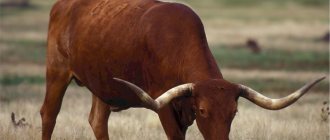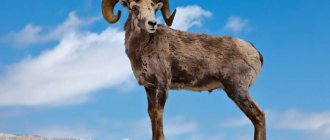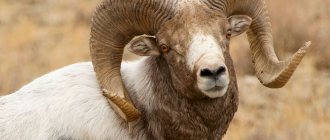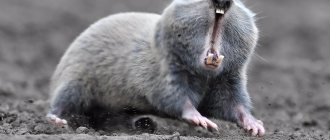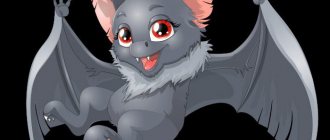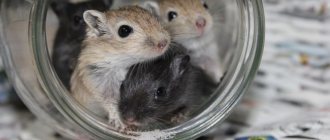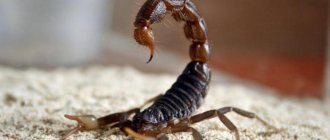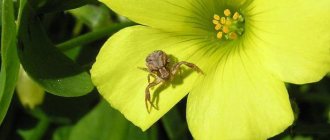The nature of the Caucasus is rich and stands out for its diversity of flora and fauna. For naturalists and biologists this is a real paradise. Most representatives of the animal world are well studied. There are also species here that are considered rare. These include the Caucasian tur, an animal listed in the Red Book.
External signs of the Caucasian tour
The Caucasian Tur is a large animal, with a massive body and neck, strong legs and a developed tail of 13-17 cm. The body length is 120 - 180 cm, the height at the withers reaches 78-112 cm. Males weigh 65-155 kg, they are much larger than females. The fur color is reddish-gray, the tail, chest and lower legs are dark, the lower part of the body is whitish. The coat is dark brown in winter, with a dark “belt” on the back and a light shade on the belly. In summer, the coat becomes grayish-brown. The beard is short, up to 70 mm, dark. The head is decorated with horns 70-100 cm long along the curve. In females, the horns are short and thin, about 20 cm.
Caucasian tour (Capra caucasica).
Pregnancy, childbirth and breastfeeding
The duration of pregnancy for a female is five and a half months. The time of appearance of kids is May-June.
A female aurochs produces kids during the warm period
The female usually gives birth to 1 kid, twins are rare. The baby immediately rises to his feet. From the age of one month, goat kids begin to eat grass, but they suck their mother’s milk almost until the end of autumn.
Goats become sexually mature at the age of three to four years. Males mature more slowly.
The life expectancy of animals is:
- in nature – 5 – 10 years;
- in captivity - 12 - 15 years.
Distribution of the Caucasian tour
Caucasian turs are endemic to the Caucasus. They are not found anywhere except the Main Caucasus Range. The Dagestan tur lives in the eastern part of the Main Caucasus Range, the western regions are inhabited by the Kuban tur.
Caucasian tours are divided into West Caucasian and East Caucasian.
The habitat of the Dagestan tur is located along the upper belt of the Main Caucasus Range east of the Terek to an altitude of up to 4000 meters above sea level. The main habitat areas are in the upper reaches of the Samur, Avar and Andiysky and Koysu, on the Talibsky, Bogossky, Nuktalinsky ridges.
Types of mountain goats
These animals belong to the family Bovids, genus Mountain goats.
The following subtypes of tours are distinguished:
- East Caucasian (Dagestan);
- Western Caucasian (Kuban, Severtsov’s tur).
These varieties are not very different from each other, so they are combined into one species, although some scientists distinguish the Kuban tur separately.
These subspecies differ in the shape of their horns. In the Dagestan goat they are short and heavy, they bend in an interesting way, which is why they are similar to those of a lamb. The Kuban, on the contrary, has long saber-shaped horns.
Dagestan
Western Caucasian
Habitats of Caucasian turs in nature
Turs prefer to feed in places where they are little disturbed. The favorite habitats of the aurochs are the upper tracts of forests at the transition points to alpine meadows.
A young individual of the Caucasian tur.
During the year, ungulates roam within one ridge and do not undertake long-distance movements. After wintering, in April-May, the tours descend from the alpine meadows to the sunny slopes of the forests. The first greenery appears there, and aurochs graze in herds of up to 100 individuals. Ungulates follow the melting snow edge; in June-July, the bulk of animals gather in the alpine belt. In the second half of summer, when it gets hot, tours stick to areas where there are glaciers. With the onset of autumn, animals descend to the upper border of the forest, where fresh greenery is still preserved in small hollows. With the appearance of the first snow, the herds move to wintering areas in the alpine belt.
Diet and habitat
The basis of the diet of these mountain inhabitants is made up of alpine grasses: cereals, bluegrass, fescue. They also eat twigs of bushes and trees, moss and lichen. In winter, the basis of their food is dry herbs, supplemented by plant shoots.
In unfavorable periods, in the absence of suitable vegetation, aurochs can even feed on poisonous herbs, such as hellebore and anemone, which are deadly to pets. To satisfy the body's need for minerals, the Caucasian mountain goat goes to salt marshes.
Turs are quite shy, so they live mainly in inaccessible places. They spend most of their time in rocks with sparse vegetation. And only in severe frosts do females with cubs head down to the forests.
Most of all, Caucasian goats love high-mountain forests that turn into alpine meadows. By the end of spring, they descend into the forest, where it is easier to find food. As the snow melts, the animals climb higher again. In mid-summer, almost the entire herd is already in the mountain meadows, and with the arrival of heat towards the end of summer, the tours rise to the glacier zone. In the autumn, goats move to the forests, since there is more vegetation there, and they winter in the territories of alpine meadows.
Peculiarities of behavior of the Caucasian tour
The Caucasian Tur is a hardy animal, adapted to the harsh conditions of the mountains. It can withstand frosts, blizzards, and snowfalls. In the places where aurochs live, other ungulates are rarely found. Turs are very careful animals. They have acute vision, a keen sense of smell and sensitive hearing. Ungulates can smell a person from several hundred meters away.
An old specimen of the Caucasian Tur.
In addition, tours have developed collective notification. In the herd there are always sentinels who inform their relatives about the approach of strangers with a snorting sound. The entire herd reacts to the signals of the sentinel tour; based on the behavior of the sentinel tour, the animals determine the presence or absence of a threat. Constantly, one or more aurochs raise their heads and survey their surroundings. A sharp whistle serves as an alarm signal. When a person appears, animals climb onto inaccessible rocks.
Animals of the Red Book of Russia
The publication “Red Book of Russia” announced its existence in 2001. This collection contains a considerable number of rare animals, their photographs and brief data.
p, blockquote 1,0,0,0,0 —>
The purpose of this publication is to attract public attention to the problem of protecting endangered animals and birds. Below is some interesting information about some of them.
p, blockquote 2,0,0,0,0 —>
p, blockquote 3,0,0,0,0 —>
It is this “lucky one” that has the largest horns. He is one of a kind.
p, blockquote 4,0,0,0,0 —>
Amur Tiger
p, blockquote 5,0,0,0,0 —>
This is the largest representative of the cat genus, which “chose” white snow and low air temperatures as its habitat. The hunting process in such conditions is quite complex. It is not easy for the tiger, however, he carries out tracking of deer and wild boars. This animal is the “pearl” of Russia. Incredibly unique! The species is quite rare and is distinguished by its expressive beauty: the belly has a five-centimeter layer of fat. Thanks to it, the animal is well protected from cold environmental conditions. Today, its population is growing in number.
p, blockquote 6,0,0,0,0 —>
Atlantic Walrus
p, blockquote 7,0,0,0,0 —>
The habitat of this representative is the waters of the Barents and Kara seas. The maximum size that the presented individual can reach is 4 meters. Its weight is also considerable - one and a half tons. There were times when this species practically disappeared. However, with the help of specialists, this individual has a slight increase in popularity.
p, blockquote 8,0,0,0,0 —>
Sea lion
p, blockquote 9,0,0,0,0 —>
This individual reaches a length of 3 meters and weighs one ton. This eared seal lives in Kamchatka and Alaska.
p, blockquote 10,0,0,0,0 —>
White-faced dolphin
p, blockquote 11,0,0,0,0 —>
A distinctive feature from other representatives of its genus is its black sides and fins. Having arrived to the shores of the Baltic Sea, you can confidently wait to meet this “handsome guy”.
p, blockquote 12,0,0,0,0 —>
Far Eastern leopard (Amur)
p, blockquote 13,0,0,0,0 —>
The species is at serious risk of complete extinction. Habitat: Primorsky Krai. Representatives of this species are also found in northeast China (in small numbers). In China, special attention is paid to the problem of protecting this species from extinction. The highest penalty for killing an individual is death. The reason for the extinction of these animals is the high percentage of poaching.
p, blockquote 14,0,0,0,0 —>
Polar bear
p, blockquote 15,0,0,0,0 —>
It is rightfully considered the largest representative of the “bear family”. In size it surpasses even the well-known grizzly bear.
p, blockquote 16,0,0,0,0 —>
Gorbach
p, blockquote 17,0,0,0,0 —>
A bright individual. It has an interesting swimming style: it arches its back. It got its name for this feature.
p, blockquote 18,0,1,0,0 —>
Red (mountain) wolf
p, blockquote 19,0,0,0,0 —>
In appearance the animal is similar to a fox. Because of its beautiful fiery red fur, hunters shot wolves, so now the population of the predator has sharply declined. At the moment, rare flocks of 12-15 individuals can be found in the Far East.
p, blockquote 20,0,0,0,0 —>
p, blockquote 21,0,0,0,0 —>
p, blockquote 22,0,0,0,0 —>
The fox of this species is small in size: body length is up to 60 cm. In summer, the animal’s fur is short and gray in color, and in winter it becomes thicker and longer, acquiring a light gray tint. The animal lives in semi-desert and steppe.
p, blockquote 23,0,0,0,0 —>
p, blockquote 24,0,0,0,0 —>
p, blockquote 25,0,0,0,0 —>
Animals of this species are under threat because people kill them for their snow-white fur, from which they sew clothes. Individuals of the blue fox live on the coast of the Bering Sea.
p, blockquote 26,0,0,0,0 —>
p, blockquote 27,0,0,0,0 —>
p, blockquote 28,0,0,0,0 —>
Snow leopards live in Central Asia, and in Russia these animals are considered rare species. Due to the fact that they live in hard-to-reach places and harsh climatic conditions, the population has not yet been completely destroyed.
Caucasian tour meals
Caucasian aurochs are herbivores. They feed on cereal plants, eating sweet grass, bluegrass, and fescue. On occasion, do not refuse hellebores and anemones, which are poisonous to domestic animals. In winter, the main food is dried grass.
The Caucasian tour rests in the shadow of a mountain ledge.
Ungulates replenish their meager winter food rations with shoots of rowan, willow, aspen, maple, fir, and pine. To compensate for the lack of mineral salts, tours willingly visit salt licks. For this purpose, they cover distances of 15-20 km. They regularly visit watering holes, especially when the grass dries out.
Other animals of the Red Book
p, blockquote 52,0,0,0,0 —>
This is a primitive type of horse, retaining the features of both the wild horse and the donkey. There are about 2 thousand individuals in the world. In Russia they live in nature reserves.
p, blockquote 53,0,0,0,0 —>
p, blockquote 54,0,0,0,0 —>
p, blockquote 55,0,0,1,0 —>
The animal looks like a donkey, but has much in common with a horse. A representative of this species lives in the wild in semi-desert and steppe.
p, blockquote 56,0,0,0,0 —>
p, blockquote 57,0,0,0,0 —>
p, blockquote 58,0,0,0,0 —>
p, blockquote 59,0,0,0,0 —>
p, blockquote 60,0,0,0,0 —>
This insectivorous animal lives in Central Russia, weighs about 0.5 kg, and body length is 20 cm. The representative is a relict species, as it has existed for about 30-40 million years, but may disappear from the face of the earth, so it is now under protection of the state.
p, blockquote 61,0,0,0,0 —>
p, blockquote 62,0,0,0,0 —>
p, blockquote 63,0,0,0,0 —>
The rodent is small in size - about 15 cm. The head and back of the animal have brown-brown fur, and white fur on the belly and cheeks. The garden dormouse lives in spruce and beech forests.
p, blockquote 64,0,0,0,0 —>
p, blockquote 65,0,0,0,0 —>
p, blockquote 66,0,0,0,0 —>
The small animal is found in Russia in the region of Western Siberia and the Ural Mountains, and lives on the banks of reservoirs.
p, blockquote 67,0,0,0,0 —>
p, blockquote 68,0,0,0,0 —>
p, blockquote 69,0,0,0,0 —>
The seal is small in size, and an adult grows up to 1.5 m, has light gray fur, and has well-developed sensory organs. Found in the Baltic Sea and Lake Ladoga.
p, blockquote 70,0,0,0,0 —>
p, blockquote 71,0,0,0,0 —>
p, blockquote 72,0,0,0,0 —>
The marine cetacean is found in the waters of Kamchatka and the Far East. Adults grow up to 8 meters in length and weigh 2-3 tons.
p, blockquote 73,0,0,0,0 —> p, blockquote 74,0,0,0,1 —>
Mating behavior
Among the Caucasian aurochs, male fights are of a ritual nature. When meeting, the males freeze one against the other, then stand on their hind legs and with a sharp movement fall down, striking with their horns. The sound of the collision can be heard more than a kilometer away. The fight ends without bloodshed. Having clashed their horns again, the males disperse.
Caucasian tours travel well in mountainous areas.
The rut of Caucasian aurochs lasts from the second half of November until the end of December. During this period, animals are kept in a mixed herd of up to a hundred heads. The young stay away from adult males and females.
Reproduction
The mountain goat is a polygamous animal . The animal gives birth to offspring once a year. The mating period falls in late autumn. At this time, sexually mature males join the herd of females. The young immediately give way to more assertive and stronger individuals. Brave battles for females begin. Adult goats enter into mating fights. It should be noted that each such fight takes place in accordance with its own strict rules, so in rare cases the animal is fatally injured. Before the battle, the opponents stand opposite each other. Rising on their hind legs, they lock horns. Mountain goats, unlike rams, do not butt into the unprotected part of the body and do not rush to catch up with the losing male.
The goat that wins the fight has the right to assemble a harem of several females. Mountain goats bear cubs for up to six months , so offspring are usually born with the onset of spring, when it is already warm. One or two kids are already timidly walking on the ground a few hours after birth. But the newly hatched offspring are vulnerable, so during the first weeks the kids hide in secluded places. The goat returns to feed them milk, after which they accompany her everywhere.
A month later, the kids begin to demonstrate excessive mobility and playfulness: they run and climb on their mother. The animal gains independence by the end of the first year of life. Puberty in goats occurs at two years, and in males a little later. Life expectancy in the wild is from 7 to 15 years.
Reasons for the decrease in the number of Caucasian tur
The Caucasian tour is under protection.
In nature, many aurochs die at an early age from persecution by predators. The main enemies are wolves and lynxes. In winter, a large number of aurochs die in avalanches. In addition, the Caucasian tur has always been the object of hunting. Tur hunting is allowed in Azerbaijan. Under a license, ungulates can be hunted in July-August.
Current situation of these animals
Since these animals have long been the object of hunting, their numbers are closely monitored by environmental and licensing authorities. Valuable trophies are the skin and meat of the aurochs, as well as its head with luxurious horns. Currently, hunting is carried out strictly under licenses, and in Georgia and in some other areas of the Caucasus Range, hunting these goats is prohibited altogether.
The total population of Caucasian mountain goats is approximately 20 - 25 thousand individuals. The main population is concentrated on the territory of the Caucasus Nature Reserve.
YouTube responded with an error: API key expired. Please renew the API key.
Bibliography:
- https://ru.wikipedia.org/wiki/Animal husbandry
- Animal husbandry // Encyclopedic Dictionary of Brockhaus and Efron: in 86 volumes (82 volumes and 4 additional). - St. Petersburg, 1890-1907.
- A.P. Soldiers. Basics of animal husbandry. — 3rd ed. - M.: Agropromizdat, 1988.
More on the topic: Properties of goat milk
Security of Caucasian tours
A special hunting reserve has been created in Azerbaijan for the reproduction of the tur; it is protected in the Zagatala Nature Reserve. According to unrefined data from 1984, 16 thousand animals live in these places.
Strict and systematic accounting of the number of rare species is necessary. When determining the hunting limit, it must be taken into account that many aurochs die at the hands of poachers. The Caucasian tur is included in the IUCN Red List as a vulnerable species, subject to extinction.
If you find an error, please select a piece of text and press Ctrl+Enter.
A little history
People began hunting mountain aurochs back in ancient times. It is believed that the first meeting of an animal and a person took place in northern Iran. Over time, people learned not only to hunt them and eat fat and meat, but also to process the skins. They were used to make containers for liquids. But the most desired trophy was and remains the horns.
To this day, it is believed that the milk of these animals is very valuable and very nutritious. In many remote settlements of the Caucasus, there are still tales that mountain goats are representatives of evil spirits. In fact, they are very smart and gentle animals that are highly trainable.
It was in honor of the Iberian goat (Capricorn) that the constellation Capricorn was named. This species lives in the vastness of the Iberian Peninsula and is famous for the amazing curves of its horns.
Methods of hunting for Tur
Tur hunting is not much different from other mountain hunts.
Historically, the local population preferred to hunt aurochs from blind spots located above bodies of water, while princes and rulers sometimes conducted large-scale hunts. But for a hunter interested in harvesting a mature old buck with big antlers, approach hunting is the solution. Like other goats and rams, the aurochs is too wary to approach from below. The hunter and guide will have to climb high into the mountains to find the right trophy, and then perhaps climb even higher and/or take a wide detour to get within shooting range. The hunter must also be prepared for a long shot from an awkward position. It is not recommended to use so-called round-up hunting, since such hunting will be hampered by the rocky terrain. High-mountain hunting is more characterized by the extraction of aurochs by stealth from an ambush or by a rush.
Rare animals from the Red Book
Back in the mid-20th century, the International Union for Conservation of Nature (IUCN) created the Commission on Rare Species, which developed an annotated list of living organisms at risk of extinction. This list was called the Red Data Book. The first IUCN Red List was published in 1963 and has been updated many times since then. Now, under a common name, there are several lists: from general - international - to regional.
- International (IUCN). As already mentioned, the first list for the IUCN Red List was compiled in 1963 and has been updated since then. The international book is a document of permanent validity, but if any species from it is no longer in danger of extinction, the “red” sheet becomes “green”.
- National Red Books are a kind of “offshoot” of the international one. In Russia, for example, there is a list of vulnerable species of animals and plants that exist on the territory of our country. In accordance with the law, the Red Book of Russia must be published at least once a decade. Currently there are 231 species on the list, of which 74 are mammals. A new edition of the Red Book was supposed to be published in 2022, but due to a change in the composition of the commission, the current list of taxa has not yet been approved.
On a note
Inclusion of a taxon in the Red Book of Russia provides it with legislative protection, that is, this species is automatically prohibited from being harvested, be it a plant, a mushroom, a reptile, a bird or a mammal.
- Regional Red Books represent a cadastre of endangered species on the territory of individual regions, republics, etc. There are more than 50 regional Red Books in Russia, for example the Red Book of Kamchatka, Voronezh Region, and the Chuvash Republic. Of course, for the most part, regional lists provide information only about part of the habitat of a particular species, but in the case of endemics, the information can be complete (for example, Golomyanka, Baikal omul).
Mammals listed in the Red Book of Russia
As we have already said, today there are more than 70 species on the list of endangered and vulnerable species in our country [3].
Insectivores
This list includes four species: the Daurian hedgehog, the Russian muskrat, the Japanese mogera, and the giant shrew.
Chiroptera
There are seven representatives of the order in the Red Book: the lesser horseshoe bat, the Megeli horseshoe bat, the greater horseshoe bat, the pointed-eared bat, the tricolored bat, the giant noctule, and the common longwing.
Rodents
Seven species of rodents are on the list of vulnerable: tarbagan (Mongolian marmot), Baikal black-capped marmot, West Siberian and Tuvan subspecies of river beaver, giant mole rat, Manchurian zokor, yellow pied.
Endangered species of animals: through the pages of the Red Book of Russia
Man, changing the world around him to suit his requirements and desires, has achieved global changes on the planet: now river flows, cloud routes, and forest growth are subject to his will. But this influence is by no means always positive: without even thinking about the consequences, our civilization sweeps away entire climatic zones from the face of the earth, erases mountains and lakes from maps, and leaves entire species of plants and animals only on the pages of reference books.
Today, according to UN statistics, 4,749 species of living organisms are on the verge of extinction, including almost 2,427 animal species and 2,314 plant species [1]. The vast majority are vulnerable due to human fault, and over the past half century, more than 50% of rare species of flora and fauna have been completely lost [2].
But, fortunately, there are people who are caring and ready to fight to preserve the environment. Organizations such as WWF, World Animal Protection, the UN and the UNEP program are making sure that our planet has a future filled with green forests and the sounds of wildlife. In this article we will talk about species that are particularly in need of protection and the measures that are being taken to preserve them.
Photo gallery
You can find out more about what representatives of the subspecies look like in the photo. Pictures can be viewed in full size by clicking on the image with the cursor. This review does not contain pictures of only one direct descendant of mountain goats - the domestic goat, since you can find out all the information on goats from another relevant section on the site.
Photo 1. Severtsov’s tour in the mountains
Photo 2. Nubian ibex
Photo 3. Ibex Capricorn in the Alps
